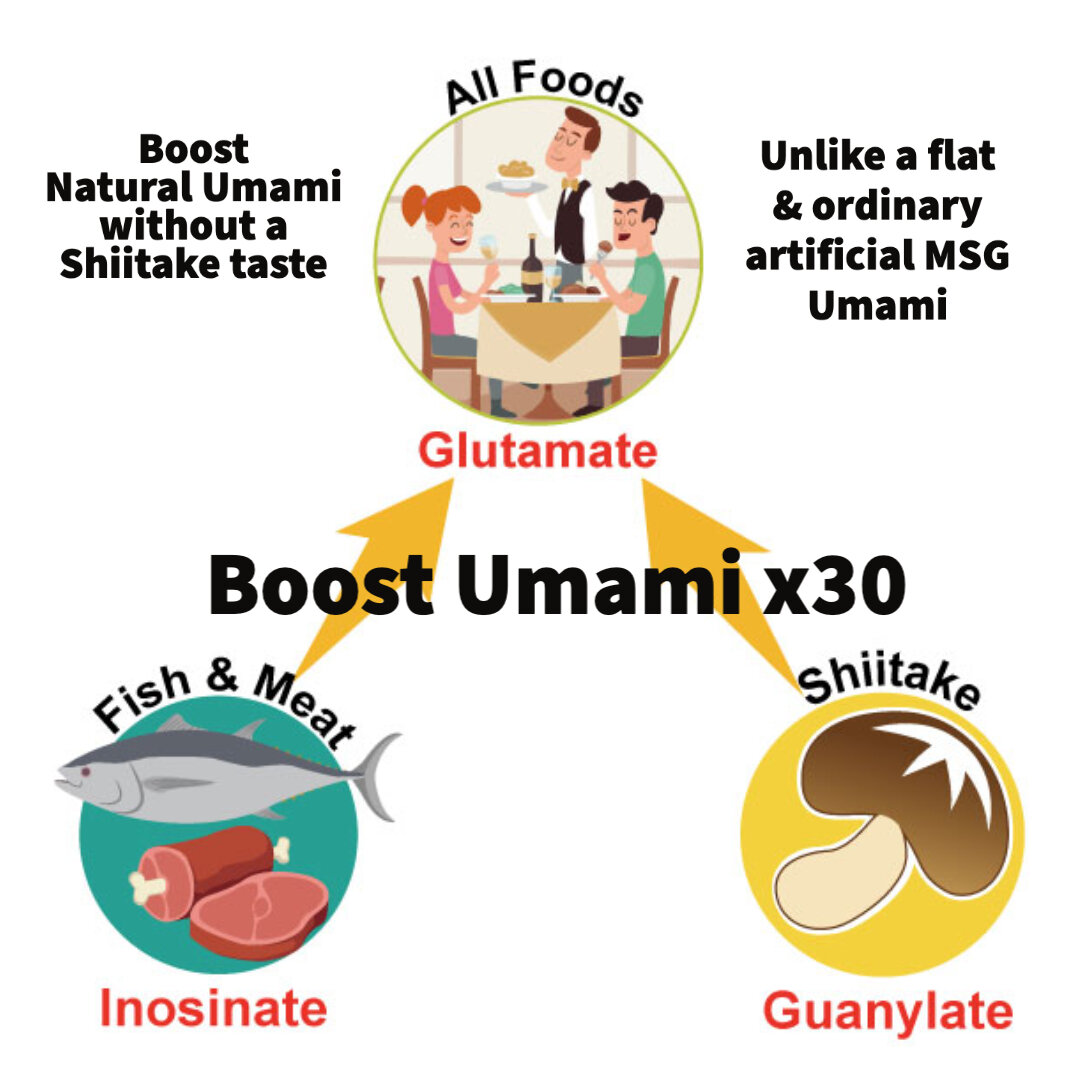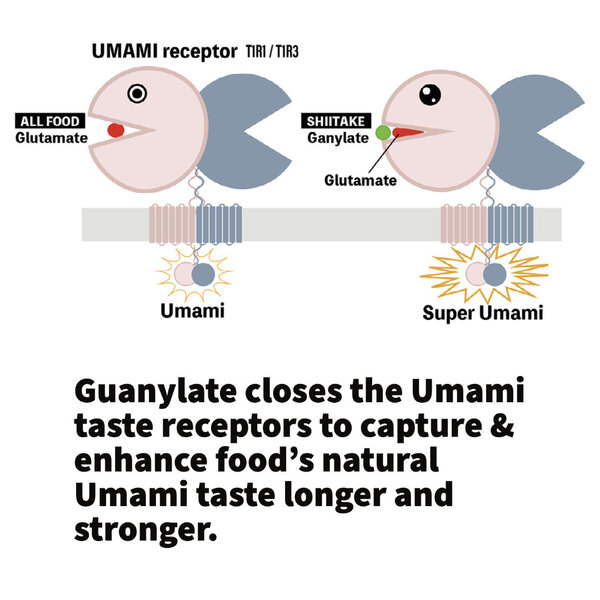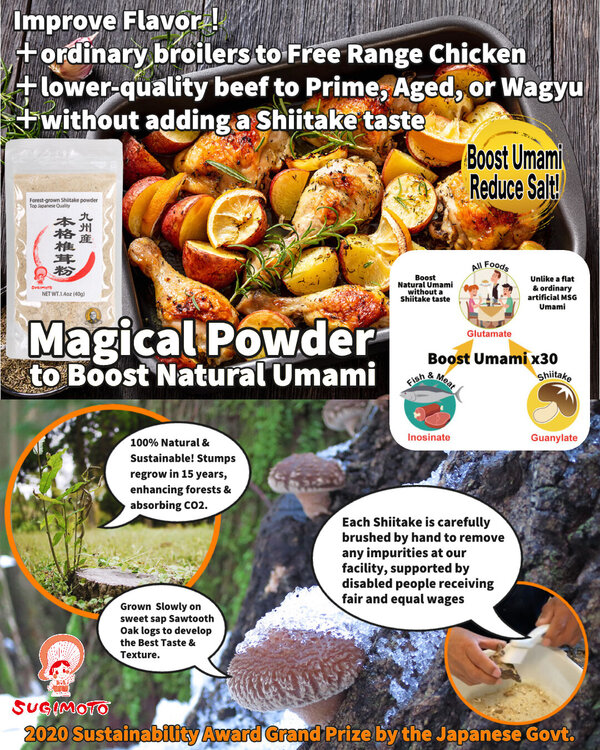Academic paper on umami synergy

Tag: #Umami #Guanylate #Shiitake #Shiitake powder #UmamiSynergy #FoodScience #TasteScience #FlavorEnhancement #AcademicResearch #Glutamate #Inosinate #CulinaryScience #UmamiResearch
Guanylate, unique to dried shiitake mushrooms, thickens other ingredients' umami (Glutamate). In other words, using dried shiitake mushrooms or shiitake powder in your cooking will make it taste even better than usual.
Here are three major academic papers that have been written about this.
1) Molecular mechanism of the allosteric enhancement of the umami taste sensation
Ole G. Mouritsen, Himanshu Khandelia, 2012
https://febs.onlinelibrary.wiley.com/doi/full/10.1111/j.1742-4658.2012.08690.x
When Glutamate enters the umami receptor, we sense umami.
Furthermore, Guanylate (the umami component of dried shiitake mushrooms) enters the receptor, closing the receptor's mouth and making us feel umami longer and stronger.
Guanylate (GMP) is a natural booster that enhances umami
-- The mechanism of umami synergy revealed by science
Umami is known as the fifth basic taste, alongside sweetness, saltiness, sourness, and bitterness. This taste is triggered by a specific amino acid called glutamate (Glu), which serves as an important indicator that helps the body recognize the presence of proteins and nutrients in food.
In the human tongue, there are specialized receptors known as umami receptors (T1R1/T1R3) that respond to glutamate. When glutamate binds to these receptors, it sends a signal from the taste cells to the brain, leading to the sensation of deliciousness.
What makes umami even more interesting is that its effect becomes significantly stronger when nucleotides like guanylate (GMP) are also present. This phenomenon has been known for a long time, but the molecular details behind it were clarified only recently.
Cooperative enhancement of umami by glutamate and GMP
Research has shown that glutamate and GMP bind to different parts of the umami receptor and work together to change its shape in a cooperative way.
A key structure in the receptor is called the Venus flytrap domain (VFTD). This part acts like a Venus flytrap plant--it opens and closes. When glutamate binds to it, the domain closes, switching the receptor to an "on" state that transmits a taste signal.
In this study, molecular dynamics simulations revealed the following:
- When glutamate is present, the VFTD tends to close
- When GMP is also present, the closed state becomes more stable
- GMP binds to a groove on the outer side of the VFTD and supports the effect of glutamate
This is the molecular basis of the well-known umami synergy.
Glutamate is familiar to us from birth
The study also highlights that glutamate is not just a taste compound. It is the most abundant amino acid in human breast milk. From the moment we are born, we are exposed to glutamate and naturally develop a sensitivity to umami. This indicates that umami serves not only as a flavor but also as a biological cue to help us recognize valuable nutrients.
Scientific analysis of natural taste mechanisms
Using computer simulations on the nanosecond scale, the researchers found that:
- Glutamate pushes the receptor toward the closed, active state
- GMP further stabilizes that state
- When both are present, the receptor stays in the "on" position longer, amplifying the taste signal
Although GMP has some effect on its own, its true power is revealed when it works together with glutamate. This cooperative action was visually and quantitatively confirmed through simulations.
Summary
- Glutamate is the main amino acid responsible for umami, and the tongue has receptors that detect it
- GMP enhances the effect of glutamate by stabilizing the receptor's active state
- The two molecules bind to different sites but work together to strengthen the signal
- The abundance of glutamate in human breast milk suggests we are naturally primed to recognize umami
In this way, the synergy of umami is a result of natural cooperation between substances that exist in the foods we eat. This paper reveals how that cooperation alters the structure of the umami receptor to amplify the sensation of taste at the molecular level.
2) Flavor potentiators
Joseph A. Maga &Shizuko Yamaguchi, 2009
https://www.tandfonline.com/doi/abs/10.1080/10408398309527364
This paper provides a comprehensive introduction to the synergistic effects of umami.
"An even more dramatic synergistic effect has been shown for MSG-GMP combinations, where a 30-fold increase in flavor intensity has been reported when equal amounts of MSG and GMP were utilized.
These data would indicate that at their optimum effectiveness MSG-GMP combinations are approximately four times more synergistically potent than MSG-IMP."
3) Taste and Flavor Enhancement using Natural Ingredients: The Prediction and Optimization of Umami Taste in Real Food Systems
Lisa Methven, Maria Dermiki, Chutipapha Suwankanit, Orla B. Kennedy, Donald S. Mottram, 2014
https://www.sciencedirect.com/science/article/pii/B9780123985491000891
This paper is a study that looked for effective natural ingredients to enhance the umami flavor of cooked minced meat products.
"Combinations of soy sauce with either mycoprotein derivative, shiitake extract, or concentrated tomato extract led to maximized umami taste in the meat."
This paper explores methods for enhancing the taste and flavor of food using natural ingredients. The study examines how various natural ingredients can be added to minced meat products, including shiitake mushroom extract, yeast extract, mycoprotein extract, miso, soy sauce, and tomato puree, to increase their umami taste.
Results showed that adding these ingredients to the meat products enhanced their umami and salt perception, with mycoprotein, shiitake mushroom, concentrated tomato extract, and soy sauce being particularly effective.
The study suggests that using natural ingredients can provide more enjoyable food options for older individuals or those with taste disorders.



